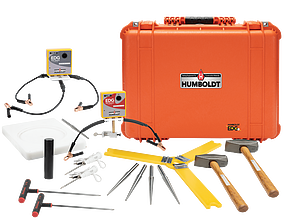Electrical Density Gauge
Humboldt‘s NEW Electrical Density Gauge Model E (EDGe) is used for determining the density and moisture content of aggregate, soil aggregate compacted type I or II base, or native soil materials that are suitable for shallow foundations, such as secondary roads or base aggregate that is compacted in-place prior to the asphalt or concrete placement at the final grade. The EDGe quality assurance / quality control (QA/QC) system is lightweight, easy to use, and nuclear free.
The EDGe consists of two independent units, one for use in the lab and one for field use, which work together with the use of a Microsoft app to ensure precise and accurate measurements. The EDGe provides a direct correlation between the Proctor test data of a representative aggregate/soil sample in the lab and readings of the same material in the field. The lab unit provides you with the tools to take readings directly from six-inch Proctor molds, while performing standard or modified Proctor tests. The field unit is lightweight and comes with a carrying case for easy transport and storage. Both units are nuclear free, which eliminates the need for radiation safety compliance regimens and transportation restrictions. The EDGe is simple to use.
The advantages of using the EDGe are:
- Complies with AASHTO T 399 and is an enhancement of ASTM D7698 that includes a Laboratory aggregate calibration procedure
- Nuclear-free device
- Accurate and repeatable results that correlate to either ASTM D1557 or ASTM D698 standard
- Proctor tests
- Does not require highly trained or licensed technicians
- Does not require special handling for shipping or regulatory compliance for hazardous materials
- Easy-to-learn and easy-to-use with its step-by-step menu
- Lightweight and easily transportable
- Eliminates costs associated with nuclear gauges
The laboratory aggregate calibration procedure involves electrical testing of a representative sample of the construction aggregate or soil materials while performing either an ASTM D1557 Standard Test Method for Laboratory Compaction using a Modified Effort of 56,000 ft-lbf/cubic foot or the ASTM D698 Standard Test Method for Laboratory Compaction using a Standard Effort of 12,000 ft-lbf/cubic.
During the laboratory test, the EDGe lab-sensor and a Windows 10 laptop or tablet are used to collect and manage the physical and electrical data during the Proctor test. The software generates a Proctor curve that displays the maximum dry density at the calculated optimum moisture content and is saved and typically printed for client reports. The empirically derived correlations relate the electrical and physical properties of the aggregate or soil that is scheduled for placement and compaction on construction project sites, such as road construction or other shallow foundation. The physical and electrical data from the Proctor test is saved on the laboratory laptop computer. This data can then be transferred to a ruggedized field Windows 10 tablet by USB stick, a cloud service, or via wireless connection for use with the EDGe field equipment for quality assurance / quality control (QA/QC) testing and construction quality certification.


